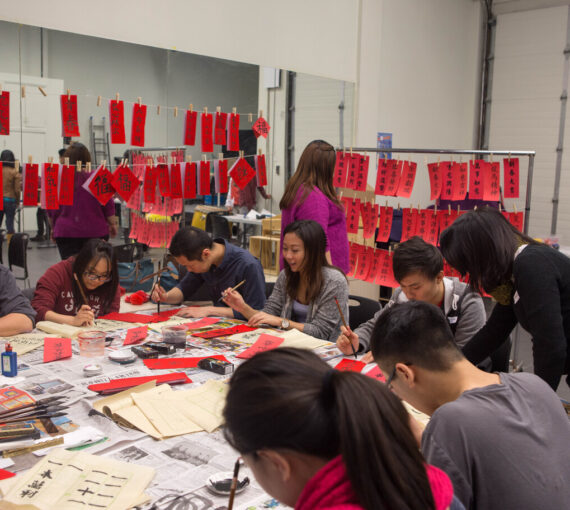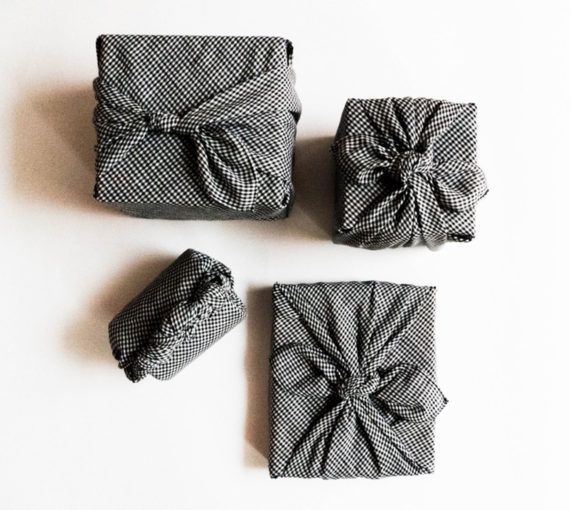
Got a stash of Lunar New Year red envelopes you’ve received? Save and reuse them instead of buying new. Invite family and friends to do the same. (Photo: HyggeLab via Unsplash)
Though the Gregorian calendar is the most widely used today, there are numerous others worldwide with their own new year celebrations and traditions. The Chinese New Year (新年) — based on the lunar calendar and referred to across cultures as the “Lunar New Year” — is celebrated for two weeks (usually between January 21 and February 20).
An estimated two billion people celebrate the Lunar New Year. You don’t have to sacrifice the sanctity of cultural traditions when incorporating sustainability into your celebrations — they often originated that way!
Making a conscious effort to green any holiday or celebration is a great opportunity to:
- Honour your culture
- Live your values
- Reduce your environmental impact
- Adopt new eco-friendly habits
- Inspire others to join you!
What's Lunar New Year?
Lunar New Year is also known as “Spring Festival.” Celebrated in China for thousands of years, it’s also marked worldwide by Chinese communities in diaspora. It’s the most dignified festival of the year for Chinese people. It’s also celebrated by cultures throughout Asia that follow the lunar calendar, with unique customs and traditions.
For most Chinese people, the Lunar New Year is “centred around removing the bad and the old and welcoming the new and the good. It’s a time to worship ancestors, exorcise evil spirits and pray for a good harvest.” For 15 or 16 days, ancestors and deities are honoured through parades, events, family reunions and traditions.
Chinese zodiac: The year of the Wood Dragon
The Chinese zodiac assigns one of twelve animals (and its reputed attributes) to each year in a repeating 12-year cycle based on the lunisolar calendar. The animals are then associated with a “nature element” — wood, fire, earth, metal or water — based on a Chinese philosophy called the “Five Elements Theory” that describes the relationship and interdependence between all things. Other cultures that follow similar astrology systems assign different animals.
The Chinese zodiac is deeply integrated into the cultural fabric of Lunar New Year celebrations. It adds layers of tradition, symbolism and excitement to the festivities, influencing everything from personal beliefs and actions to larger community celebrations. The year’s designated animal for that year is prominently featured in decorations, parades, traditional performances and various festive items.
The next Lunar New Year begins on February 10, 2024, and — in Chinese tradition — ushers in the Year of the Dragon, more specifically, the Year of the Wood Dragon. In Chinese folklore, the dragon is a majestic, lucky creature that symbolizes bravery, creativity and innovation. The Wood Dragon is said to be the most creative and visionary of the dragons.
Integrate these themes into your environmentalism this year — be brave, creative and innovative!
Eco-friendly Lunar New Year traditions and celebrations
Sustainable practices are deeply embedded in Chinese tradition and values. Reverence for nature in the arts, health and spirituality are some examples. Day-to-day habits, such as the Chinese adage wù jìn qí yòng — translated roughly as “waste not, want not” — also remind us of that.
Common traditions for Chinese people at Lunar New Year are big family reunion dinners, gifting red packets or envelopes, house cleaning and decorating. Though many of these aspects of the holiday are sacred, there are still ways to limit or reduce your environmental impact.

Chinese-Canadian youth setting an example
Across U-hub is a charitable community organization in the Greater Toronto Area. It aims to build up young people’s lives by inspiring individuals and motivating collective goals and actions. To prepare for the Lunar New Year, participants are encouraged to explore new ways of honouring their culture while championing sustainable practices, such as making DIY festive decorations.
Worldwide, young people are not waiting for climate action. Across U-hub’s initiatives are an example of how to empower the next generation to actively contribute to the wellbeing of the planet by infusing traditional celebrations with an Earth-friendly mindset.
Transportation
In China, hundreds of millions of workers making their living in factories away from home (as well as expats overseas) return to their hometowns to celebrate Lunar New Year with their families. Chūnyun, which means “spring migration,” describes the significance of this travel, which lasts for 40 days and often overwhelms transport terminals.
If your family lives abroad:
- Choose airlines carefully. Some are taking steps to reduce carbon pollution. Pick carriers that have an efficient fleet and fly their planes with few or no empty seats.
- Fly economy. Flying business class produces three times more carbon emissions per passenger.
- Take direct, non-stop flights. Avoid emissions from multiple takeoffs and landings.
- Take daytime flights. Contrails are water droplets or ice crystals visible in aircraft engine exhaust. They play a significant role in global warming. Fly in daytime to avoid the heat-trapping effects of contrails and cirrus clouds at night.
- Offset. If you must fly, consider purchasing carbon offsets that meet the Gold Standard.
If your family lives nearby:
- Use public transportation. Take the bus, train, subway or streetcar. Public transportation helps get cars off the road, reduces congestion, alleviates stress and significantly improves health.
- Carpool. Are other community members going to the same place or somewhere along the way? Drive with a full or nearly full vehicle instead of solo.
- Choose active transportation. If possible, use human-powered transportation. This includes but is not limited to walking, cycling, skateboarding or using a wheelchair.

Air travel and climate change
Because aircraft emissions are released high in the atmosphere and stay there, they have a potent climate impact, triggering chemical reactions and atmospheric effects that will heat the planet for centuries.
Cleaning and decluttering
Cleaning and decluttering are common activities planned before the turn of the Lunar New Year to rid the home of bad luck and misfortune and create space and good luck.
- Declutter room by room. This will make the activity more organized and manageable.
- Use green cleaners or make your own. Get the cleaning power you want without harsh chemicals.
- Donate what you don’t need. Don’t landfill.
- Recycle appropriately.
Decorations
Home decorating for Lunar New Year is more than a visual celebration. It’s also intended to drive off bad luck and usher in good luck. Nearly all involves the colour red and lucky images and symbols.
- Use decorations made from eco-friendly materials. When buying new, seek out those made from materials such as bamboo or rice paper, which are reusable, easy to recycle — even biodegradable.
- Re-use decorations. Instead of buying new zodiac-specific decor each year, purchase what’s reusable any year, for many years.
- Make your own confetti. Confetti is commonly made from plastic and/or harmful dyes. It pollutes the environment, harms wildlife and contains microplastics. Instead, use a hole puncher on fallen leaves you’ve collected.
- Support local florists. It’s customary for people to buy orchids, chrysanthemums, narcissuses, peach blossoms, anthuriums and lotus flowers, which symbolize good fortune. Avoid plastic-wrapped, often pesticide-treated flowers sold in most retail stores. Instead, support local florists or growers.
- Use LED lights. Lighting is a key component to Lunar New Year decorations. Use energy-efficient bulbs.
- Write your own Chinese calligraphy couplet. Fai Chun is a traditional decoration, often handwritten, that symbolizes “good luck” and “prosperity.” Write yours on recyclable paper.
Gift giving and red envelopes
Beautifully adorned red envelopes or red packets are given during many special occasions in China and holidays such as Lunar New Year. They typically contain money and are given to younger family members, especially children and unmarried people as a way to share blessings and wishes for a prosperous and happy new year.
In the South China Morning Post, non-governmental organization Greeners Action said approximately 16,300 trees are harvested every year to exchange 320 million red envelopes during Lunar New Year in Hong Kong alone.
- Reuse envelopes. If you have a stash of envelopes you’ve received, reuse them. Invite family and friends to do the same.
- Gift a virtual red envelope. Limit waste by sending your red envelopes of money virtually. In 2016, more than 100 billion virtual envelopes were sent over Lunar New Year.
- Make your own. Use crafting supplies you have at home. It reduces waste from buying and adds a personal touch!

Personal anecdote from David Suzuki Foundation staff
“One of the highlights of Lunar New Year for the younger and unmarried is receiving red envelopes from family elders.
“Imagine a 27-year-old man asked by his grandmother to give back all the red envelopes he received! Grandma had become concerned about the waste. She asked her grandson to keep the cash and give her the used red envelopes so that she could give him them in the future without further harming the planet her grandson would inherit.
“When it has all been explained, the problem was solved together. Grandma and grandson are now determined to help the planet, one red envelop and Lunar New Year at a time!”
Winnie Hwo, senior public engagement specialist
Food
During most holidays and celebrations, food is a focal point. Lunar New Year is no exception.
- Limit food waste. Ask dinner guests to bring their own containers to bring leftovers home. Store food properly. Make the most of food scraps. Compost.
- Try plant-based versions of traditional dishes. It’s a tradition to eat vegetarian on the first day of Lunar New Year to detox the body and bring good karma into the new year. Maintain that energy — try swapping out one or two traditional meals with plant-based versions. You’ll lighten your carbon footprint and try something new! (Take it a step further by making more plant-based eating a resolution for the year ahead.)
- Choose organic. Organic food is better for the climate, animals and soil. Organic farms promote genetic diversity, create less water pollution and soil damage, and reduce harm to farm workers and wildlife.
- Support local farmers. If you can, buy meat, fish and produce from local, organic producers. Food grown locally produces fewer transportation emissions, is fresher and supports local farmers.
- Bulk buy. Instead of getting a pre-packaged version of treats for traditions like the Lunar New Year candy box, go to a zero-waste or bulk store to stock up on products you can package yourself.
- Choose sustainable seafood. Seafood represents abundance, so tends to be a holiday staple. Buy sustainably sourced seafood.
Lunar New Year celebrations throughout the world
Lunar New Year is celebrated in many countries where people of diverse cultures who observe the lunar calendar live. Though customs vary, they all demonstrate humanity’s interconnectedness to natural cycles like the moon.
Here are some examples of other ways people recognize and celebrate the start of the Lunar New Year:
Lunar New Year traditions connected to nature
- Vietnam. Vietnam’s largest celebration of the year, Tết, carries spiritual values and deep emotional ties. Families erect a tall bamboo pole adorned with colourful ribbons, paper flowers and trinkets at the entrance of their homes or in a communal area. This tradition comes from Vietnamese people’s belief in the spiritual connection between humans and nature.
- Mongolia. Tsagaan Sar means “White Moon” and highlights the purity of intent and whiteness of spirit for the upcoming year. On the first day of the year, men climb the nearest hill to watch the first sunrise. Women prepare milk tea as an offering to Earth.
- Korea. Seollal spans three days, beginning on the first day of the Korean lunisolar calendar. During the celebrations, families play traditional games like the garden game neolttwigi. Participants stand on each side of a board balancing on a log and jump to propel the person opposite into the air. Simple fun outdoors.
- Tibet. Losar is celebrated in western China, Nepal, Bhutan and northern India. On the first day of the new year, women collect the year’s first bucket of water from a nearby river or well. This is believed to be pure and blessed with good luck for the coming year.
- Nisga’a. The Indigenous nation whose traditional territory is in the Nass River valley of northwestern British Columbia marks the new year, Hobiyee, by the emergence of the first crescent moon in February or March. If the crescent of the moon is open, the people believe food will be overflowing, salmon will return, hunting and berry picking will be fruitful and the year will be bountiful. If the crescent is closed, they believe it means that it will be a difficult year for winter food harvesting.



